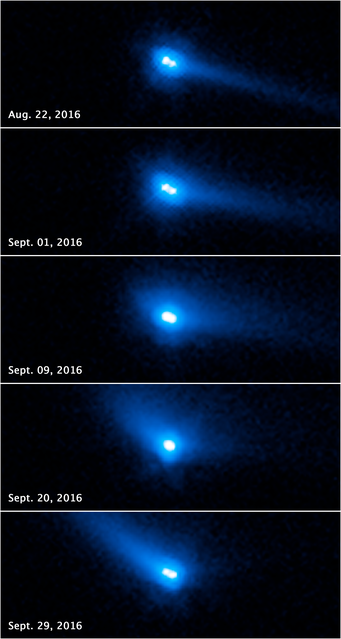The double asteroid
An object with the name 288P is the only known active asteroid comprising two components
Body 288P, which orbits the Sun in the asteroid belt between the orbits of Mars and Jupiter, is unique: It not only belongs to the group of unusual asteroids discharging dust and gas into space – and thus behaving highly atypically for a ‘resident’ of the asteroid belt – it also comprises two separate components rotating around a common centre of gravity. This is suggested by Hubble Space Telescope data, which a team of scientists under the leadership of the Max Planck Institute for Solar System Research, has now analyzed. This makes 288P the first know active binary asteroid. It probably broke into two pieces not more than 5000 years ago under the force of its own rotation.

Two instead of one: This set of photos from the ESA/NASA Hubble Space Telescope reveals the binary nature of asteroid 288P and show comet-like features. These include a bright halo of material, called a coma, and a long tail of dust.
Comets spend most of their time at the solar system's icy-cold outer limits. When their highly elliptical orbits lead them closer to the Sun, they become active: frozen gases sublimate and carry dust particles into space. Asteroids (also known as planetoids) – although similar in size and shape – are comparatively permanent, unchanging heavenly bodies: they orbit the Sun in the asteroid belt, which extends between the orbits of Mars and Jupiter.
In recent years, researchers have discovered an increasing number of bodies that do not fit into this clear pattern. The newly investigated 288P also belongs to this group. The so-called active asteroids reside in the zone between Mars and Jupiter, but display behaviour similar to comets. There can be a variety of causes for the unusual ejections of dust and gas: while some bodies lose material as a consequence of their own rotation, others are impacted by smaller bodies. Such an impact can not only kick up dust, but also expose frozen gases in the asteroid's interior, which then sublimate.
Around 20 of these exotic bodies are currently known. However, 288P stands out because of a further property: it consists of two separate pieces rotating around a common centre of gravity.
“We became aware of 288P as early as 2011”, says Jessica Agarwal, scientist at the Max Planck Institute for Solar System Research and main author of the study, now published in the journal Nature. There were clear indications of activity in Hubble Space Telescope images. However, the great distance of 288P from Earth at the time did not allow its shape to be studied in more detail.
In September 2016, the conditions were more favourable. En route to perihelion, the asteroid approached Earth to within only slightly more than 200 million kilometres. Two separate pieces could then be clearly recognized.
Extensive analyses of the data now reveal a body unique in many ways. The two individual pieces making up 288P are each about one kilometre in diameter. Simulations reveal that the two components are unusually far apart: they circumnavigate each other on a highly elliptical orbit with a magnitude of around 100 kilometres.
The fact that the body always becomes active when it approaches the Sun also indicates that exposed, sublimating gases drive its activity. “288P must have broken up barely more than 5000 years ago”, says Agarwal. Otherwise, the gases would have completely dissipated long ago, because of the asteroid belt's relative proximity to the Sun.
The analyses provide even more information on the evolutionary history of the unusual body. “We believe that 288P was created in a similar process as many other binary asteroids”, says the Max Planck researcher. An asteroid may become unstable and eventually break apart under the force of its rapid rotation. Among other things, the fact that the orbit of the two components around each other is in the same plane as their common orbit around the Sun, speaks in favour of this theory. This constellation is improbable for asteroids breaking up as the result of a violent impact.
In the researchers’ opinion , the body continued to change following its splitting apart. “288P's activity probably played a decisive role in its further evolution”, according to Agarwal. The gas, which now sublimated and ejected fountains of dust, altered the system's orbital torque. As a result, the individual components drifted further apart – eventually reaching the unusually large separation they maintain today.
Bodies such as 288P can help researchers to understand how our cosmic neighbourhood developed and continued to evolve. For example, they can help to answer the question of where water may still exist in the asteroid belt. It is currently uncertain whether the newly discovered asteroid is unique or simply the only known case.
BK / HOR












